*NURSING > ATI MEDICAL SURGICAL > NURSING 2092 MED SURG PRACTICE A Questions and Answers,100% CORRECT (All)
NURSING 2092 MED SURG PRACTICE A Questions and Answers,100% CORRECT
Document Content and Description Below
NURSING 2092 MED SURG PRACTICE A Questions and Answers A nurse is reinforcing teaching with a client who has mitral valve disease. Which of following statements by the client indicates an understandi... ng of the disease process? A. "I should call my doctor if I get a headache." B. "I might develop gastric reflux." C. "I might develop excessive bruising." D. "I should call my doctor if my ankles swell." RAT: Swelling of the ankles can indicate heart failure. The client should report this finding to the provider. A provider might prescribe anticoagulants to prevent thrombus formation on the valve, which can cause excessive bruising for a client who has mitral valve disease. However, excessive bruising is not a direct result of the disease. A nurse is reinforcing teaching about joint protection with a client who has an acute exacerbation of rheumatoid arthritis. Which of the following information should the nurse include in the teaching? A. Apply cold packs to the inflamed joints. B. Participate in high-impact exercise. C. Carry a hand purse rather than a shoulder bag. D. Sleep on a soft foam mattress. RAT: The nurse should instruct the client to use both warm and cold packs on inflamed joints to decrease pain. A nurse is collecting data from who has hypothyroidism. Which of the following manifestations should the nurse anticipate? A. Blurred vision B. Insomnia C. Bradycardia D. Weight loss RAT: The nurse should identify that bradycardia is a manifestation of hypothyroidism that is caused by a decrease in the client's metabolic rate. A nurse is reinforcing teaching with an adolescent child regarding testicular self-examination. Which of the following statements by the client indicates an understanding of the teaching? A. "I will perform the exam before I shower." B. "I will check my testicles every 6 months." C. "I understand that testicular cancer is typically painless." D. "I understand that pea-sized lumps are normal." RAT: Clients should report a lump that is not painful because testicular cancer is typically painless. Clients should perform a testicular self-examination after a warm shower. Clients should perform a testicular self-examination monthly. A nurse is contributing to the plan of care of a client who is at risk for osteoporosis. Which of the following interventions should the nurse include to prevent bone loss? A. Increase fluid intake. B. Encourage range-of-motion exercises. C. Massage bony prominences. D. Encourage weight-bearing exercises. Weight-bearing exercises, such as walking, can maintain bone mass by reducing bone demineralization, thus helping to prevent osteoporosis. A nurse is reinforcing teaching about management of constipation with a client who has hypothyroidism. Which of the following instructions should the nurse include in the teaching? A. Increase intake of fiber-rich foods. B. Take a laxative every morning. C. Maintain a fluid intake of 1,200 mL/day. D. Limit activity to preserve energy. RAT: The nurse should instruct the client to increase the amount of fiber-rich foods in their diet. Dried beans and brown rice are examples of fiber-rich foods. The nurse should instruct the client to increase activity to stimulate the evacuation of stool. A home health nurse is reinforcing teaching with a client about preventing complications of peripheral vascular disease. Which of the following statements indicates that the client is adhering to the nurse's instructions? A. "I apply rubbing alcohol to my feet every day to prevent infection." B. "I will wear clean, knee-high wool socks every day to help improve my circulation." C. "I use hot water bottles to keep my feet warm at night." D. "I don't cross my legs anymore." RAT: Clients who have peripheral vascular disease should not cross their legs because it can impede circulation. A nurse observes a client who is lying in bed and experiencing a tonic-clonic seizure. Which of the following actions should the nurse take? A. Lower the side rails of the client's bed. B. Apply wrist restraints to the client. C. Position the client in the semi-Fowler's position. D. Loosen clothing around the client's neck. RAT: The nurse should loosen clothing around the client's neck to maintain an open airway and prevent aspiration. A nurse is reinforcing teaching with the caregiver of a client who is terminally ill about manifestations of impending death. Which of the following manifestations should the nurse include? A. Incontinence of bowel and bladder B. Increase in heart rate C. Warmness of the skin D. Hypertension RAT: The nurse should inform the caregiver that incontinence of the bowel and bladder is a manifestation of impending death. Other manifestations include hypotension, bradycardia, restlessness, and coolness of the skin. A nurse in an oncology clinic is reinforcing teaching about Mohs surgery with a client who has skin cancer. Which of the following information should the nurse include in the teaching? A. Mohs surgery is a horizontal shaving of thin layers of the tumor. Mohs surgery uses liquid nitrogen to destroy the cancerous tissue. Mohs surgery is the preferred treatment for melanoma skin cancer. Mohs surgery is a palliative treatment for metastatic skin cancer. RAT: Mohs surgery is performed to treat basal and squamous cell carcinoma. The procedure, which involves a horizontal shaving of thin layers of a tumor, has a high success rate. A nurse is assisting in the plan of care for a client who has had a recent left hemispheric stroke. Which of the following actions should the nurse include in the plan? Observe for impulsive behavior. Approach the client from the right side. Use simple verbal cues when directing tasks. Place the client in low-Fowler's position during meals. RAT: The nurse should expect a client who had a left hemispheric stroke to manifest some degree of expressive and/or receptive aphasia. Using simple verbal cues will assist the client in understanding spoken communication. A nurse is caring for a client who reports stomatitis. Which of the following dietary recommendations should the nurse make? "Eat soft foods." "Season foods with salt." "Select foods that are low in protein." "Choose foods that are served hot." RAT: The nurse should instruct a client who has stomatitis to eat soft, nonirritating foods to decrease irritation to the oral mucosa. A nurse is reviewing the laboratory result of a client who has chronic kidney failure and is receiving epoetin alfa. The nurse should identify that which of the following laboratory values indicates the treatment is effective? BUN 40 mg/dL Hgb 11 g/dL Urine specific gravity 1.035 Blood glucose 105 mg/dL RAT: Epoetin alfa stimulates the production of erythropoietin and red blood cells, resulting in increased hemoglobin levels. Therefore, a hemoglobin level of 11 g/dL indicates the epoetin alfa treatment is effective. A nurse assisting in the care of a client who has manifestations of sepsis. Which of the following provider prescriptions should the nurse implement first? Collect a sputum culture. Administer ceftriaxone by intermittent IV bolus. Initiate oxygen at 4 L/min via nasal cannula. Obtain blood cultures. RAT: When using the airway, breathing, circulation approach to client care, the first action the nurse should take is to initiate oxygen. Clients who have manifestations of sepsis are often hypoxic, tachypneic, or have a PaCO2 level less than 32 mm Hg. The nurse should provide supplemental oxygen to keep the client's oxygen saturation levels at 95% or greater, which will maximize the ability of the hemoglobin to support the oxygen needs of the body. A nurse is reinforcing teaching with a client who is scheduled for a guaiac fecal occult blood test. Which of the following instructions should the nurse include in the teaching? Do not eat or drink for 6 hr prior to the test. Ensure that the stool specimen is obtained in the morning. Take ibuprofen for mild pain until the test is complete. Avoid eating red meat for 3 days prior to the test. RAT: The nurse should instruct the client to avoid eating red meat for 3 days prior to the guaiac fecal occult blood test because this can lead to a false positive result. A nurse is reinforcing discharge teaching with a client who has cirrhosis. Which of the following instructions should the nurse include ? "You can take acetaminophen for pain." "Consume a diet that is high in animal protein." "Sleep lying flat on your back." "Consume foods that are low in sodium." RAT: The nurse should instruct the client to consume foods that are low in sodium to reduce the development of edema and ascites. A nurse is caring for a client who has a compound fracture of the femur and was placed in balanced suspension skeletal traction 4 days ago. Which of the following actions should the nurse take? Perform pin site care daily. Remove the overbed trapeze. Remove the boot every 2 hr. Keep the weights on a stable, flat surface. RAT: The nurse should perform pin site care daily with chlorhexidine solution or use a solution according to facility protocol. The nurse should also monitor the pin sites for manifestations of infection. A nurse is caring for a client and administer penicillin IM. The client begins exhibiting hives and has severe difficulty breathing. After establishing a patent airway, which of the following actions should the nurse take next? Administer epinephrine. Monitor the client's vital signs. Monitor the client's oxygen saturation level. Administer an antihistamine. RAT: The greatest risk to the client is death from anaphylaxis. Therefore, the nurse should administer epinephrine to reduce bronchospasms and laryngeal edema. A nurse is caring for a client who is 1 day postoperative following a hip arthroplasty. The client is exhibiting hypotension, tachycardia, and tachypnea. The nurse should recognize that these findings indicate which of the following complications? Wound infection Pulmonary embolism Thrombophlebitis Paralytic ileus RAT: Manifestations of a pulmonary embolism include hypotension, tachycardia, and tachypnea. A nurse is examining a client's IV site and notes a red line up their arm. The client reports a throbbing, burning pain at the IV site. The nurse should identify that the client's manifestations indicate which of the following complications of IV therapy ? Thrombophlebitis Infiltration Hematoma Venous spasms RAT: The nurse should identify pain, warmth, and a red streak up the arm as indications of thrombophlebitis. A nurse is preparing to auscultate the bowel sounds of a client who has a mechanical bowel obstruction in the descending colon. When listening in the left upper quadrant, the nurse should identify this sound as which of the following? Hyperactive bowel sounds Friction rub Normal bowel sounds Abdominal bruit RAT: A mechanical bowel obstruction prevents a portion or all of the bowel contents from moving forward through the bowel. The nurse should expect to auscultate high-pitched, hyperactive bowel sounds above the point of the intestinal obstruction as the intestines attempt to propel the blockage forward. A nurse is reinforcing teaching about glycosylated hemoglobin (HbA1c) testing with a client who has diabetes mellitus. Which of the following statements indicates that the client understands the teaching? "The HbA1c test should be performed 2 hr after I eat a meal that is high in carbohydrates." "The HbA1c test can help detect the presence of ketones in my body." "I will have my HbA1c checked twice per year." "I will plan to fast before I have my HbA1c tested." RAT: An HbA1c test provides the client's average glucose level for the preceding 3 months. The nurse should instruct the client to have their HbA1c tested twice yearly to manage their glucose. A nurse is contributing to the plan of care for a client who was admitted to the neurological unit following a stroke 3 hr ago. Which of the following interventions should the nurse identify as the priority? Encourage the client to participate in self-care. Assist the client with active range-of-motion exercises. Keep the client in a side-lying position. Maintain the client's body alignment. RAT: The greatest risk to the client following a stroke is aspiration. The nurse should position the client in a lateral, or side-lying, position to allow any secretions to drain out of the mouth, decreasing the risk for aspiration. Additionally, the nurse should have suction equipment available in the event that any secretions are present in the oral cavity. A nurse is reinforcing teaching with a client who is on a low-sodium diet and asks about how to improve the taste of bland food. Which of the following foods should the nurse recommend? Ketchup Mayonnaise Soy sauce Lemon juice RAT: The nurse should recommend that the client use lemon juice to flavor their food because it is low in sodium. A nurse is reviewing the laboratory results of a client who has type 2 diabetes mellitus. The nurse should identify that which of the following laboratory values indicates the client is at risk for delayed wound healing? HbA1c 6% Prealbumin 12 mg/dL WBC count 8,000/mm3 Creatinine 0.8 mg/dL RAT: This laboratory value is below the expected reference range, indicating that the client's protein status is inadequate and that they are at risk for delayed wound healing due to malnutrition. A nurse is preparing to perform intermittent urinary catheterization for a female client who has been unable to void following surgery 6 hr ago. Which following catheters should the nurse use to perform this procedure? RAT: This is an intermittent straight catheter and is the correct catheter for the nurse to use. A nurse is participating in a health fair for older adult clients. Which of the following vaccines should the nurse recommend for this age group? Meningococcal Herpes zoster Human papillomavirus (HPV) Measles, mumps, and rubella (MMR) RAT: The nurse should recommend the herpes zoster vaccine for adults who are 60 years of age and older. A nurse is reinforcing with a client who has multiple sclerosis and a new prescription for baclofen. Which of the following instructions should the nurse include in the teaching? Consume a low-purine diet. Avoid stopping this medication suddenly. Use chamomile tea to alleviate insomnia. Take this medication on an empty stomach. RAT: The nurse should instruct the client to avoid stopping baclofen suddenly because it can result in adverse reactions, including seizures, paranoia, and hallucinations. A nurse in a long-term care facility is collecting data from a client who reports fullness in the rectum and abdominal cramping. which of the following findings should indicate to the nurse that the client might have a fecal impaction? Halitosis Hemorrhoids Rebound tenderness Small liquid stools RAT: Small liquid stools can be the result of fecal material being expelled around an impaction. A nurse is discussing health screening guidelines with an older client. Which of the following statements should the nurse include? "You should have a screening for glaucoma every 5 years." "You should have a physical examination every other year." "You should have your hearing checked every 2 years." "You should have a pneumococcal immunization every 10 years." RAT: The nurse should remind the client to have a pneumococcal immunization at age 65 and every 10 years thereafter to protect them from acquiring pneumonia. A nurse is reinforcing teaching with the caregiver of a client who has a cervical injury and has a halo vest in place. which of the following safety precautions should the nurse include in the teaching? Clean the pin sites every 72 hr. Use the halo ring to reposition the client when in bed. Change the sheepskin liner weekly. Tighten the traction bar as needed. RAT: The nurse should provide instruction regarding the care and maintenance of the vest. The instruction should include changing the sheepskin liner either when soiled or at least once per week to prevent skin irritation. A nurse is reinforcing teaching with a client who is to begin using an insulin pump. Which of the following instructions should the nurse include? "Insert the infusion needle into intramuscular tissue." "Change the needle every 5 days." "Calculate the insulin for each meal by using an insulin-to-protein ratio." "Use rapid-acting insulin in the infusion device." RAT: The nurse should instruct the client to use rapid-acting insulin with an insulin pump. A nurse is contributing to the plan of care for a client who has peripheral arterial disease of the lower extremities. Which of the following interventions should the nurse include? Place moist heat pads on the extremities. Perform manual massage of the affected extremities. Dangle the extremities off the side of the bed. Apply support stockings before getting out of bed. RAT: The nurse should include in the plan of care to have the client dangle their lower extremities off the side of the bed to aid in reducing pain by increasing arterial blood flow. The client should not raise the lower extremities above the level of the heart when resting in bed because it impairs arterial blood flow. A nurse is planning to implement droplet precautions for a client who has manifestations of pertussis. Which of the following interventions should the nurse include when contributing to the plan of care? Apply a mask on the client if transport is needed. Wear a mask when working within 1.2 m (4 feet) of the client. Don a gown when visiting with the client. Wear an N95 mask when entering the client's room. RAT: The nurse should apply a mask to a client who has manifestations of pertussis during transport to prevent exposure to others. A nurse is preparing to administer scheduled medications to a client. Which of the following prescriptions should the nurse verify with the provider? Ceftriaxone Diltiazem Pioglitazone Hydrocodone 5 mg/acetaminophen 500 mg RAT: Clients who have a severe sensitivity to penicillin can have a cross-sensitivity reaction to ceftriaxone, a cephalosporin. Therefore, the nurse should contact the provider to clarify the prescription. A nurse is caring for a client who sis 3 days postoperative following a total right hip arthroplasty. Which following actions should the nurse take? Use a traction boot to keep the client's right leg internally rotated. Have the client sit in a reclining chair when out of bed. Maintain abduction of the client's right leg while in bed. Encourage the client to perform passive range-of-motion exercises. RAT: The nurse should maintain abduction of the client's right leg to prevent dislocation of the affected hip by placing an abductor pillow between the client's legs when resting in bed. A nurse is contributing to the plan of care for a client who has Meniere's disease. Which of the following interventions should the nurse include in the plan of care? Increase the client's fluid intake. Assist the client with changing positions often. Encourage the client to rest in a well-lit room. Administer an antiemetic to the client. RAT: The nurse should plan to administer an antiemetic to a client who has Ménière's disease to reduce the duration and severity of the attack. A nurse is contributing to the plan of care for a client who is having difficulty eating following a stroke. Which of the following actions should the nurse make first? Collaborate with a dietitian. Ensure that the client is provided with a high-fiber diet. Implement recommendations from the speech language pathologist. Request a referral for an occupational therapist. RAT: The greatest risk to the client following a stroke is injury from aspiration. Therefore, the first intervention the nurse should include in the plan of care is to implement recommendations from the speech language pathologist. A speech language pathologist can conduct a swallow study to determine the client's risk for aspiration, provide teaching to the client regarding swallowing techniques, and recommend the consistency of foods and liquids for the client. A nurse is caring for a client who has terminal pancreatic cancer. The client states, "I don't think I can go on any longer." Which of the following responses should the nurse make? "Are you experiencing abdominal pain?" "You should talk about this with the people you're closest to." "Many people who have cancer feel this way." "You feel like you want to discontinue treatment?" The nurse is clarifying and acknowledging the client's feelings by establishing a trusting relationship. This question encourages the client to expand on their feelings. A nurse is caring for a client who is in Buck's traction. Which of the following interventions should the nurse perform to reduce skin breakdown? Keep the skin dry and free of perspiration. Use hot water and antibacterial soap to bathe the client. Massage the skin over bony prominences to promote circulation. Limit the use of moisturizers on the skin over bony prominences. RAT: The nurse should not leave moisture on the skin for prolonged periods of time because it can cause skin breakdown. A nurse is preparing to administer furosemide to a client who has heart failure. Which of the following findings should the nurse report before the administering the medication? Elevated sodium Elevated blood pressure Decreased potassium Decreased urine output RAT: The nurse should notify the provider immediately about a decreased potassium level because potassium is lost when a diuretic, such as furosemide, is administered, which can cause hypokalemia. The nurse should expect a client who has heart failure to have a decreased urine output and does not need to report this finding to the provider before administering the medication. Furosemide is a diuretic, which should cause an increase in urine output for a client who has heart failure.The nurse should expect a client who has heart failure to have an elevated blood pressure and does not need to report this finding. Furosemide is a diuretic that should help to lower the client's blood pressure. The nurse should report a decreased sodium level to the provider before administering the medication because furosemide can cause hyponatremia. A nurse is assisting with the care of a client who is receiving 0.9% sodium chloride by continuous IV infusion. The client reports pain and swelling at the IV site. In which order should the nurse perform the following steps? 1. Check the IV site 2. Stop the infusion 3. Withdraw the IV catheter 4. Elevate the affected arm 5. Notify the charge nurse A nurse is caring for a client who is preoperative and is receiving an IV infusion of cefazolin. Ten minutes after beginning the infusion, the client reports intense itching. Which of the following actions should the nurse take first? Stop the medication infusion. Notify the charge nurse. Administer a PRN dose of diphenhydramine. Follow facility policy for appropriate reporting of the adverse reaction. RAT: The greatest risk to the client is injury from an allergic response to the medication. Therefore, the first action the nurse should take is to stop the medication infusion. A nurse is caring for a client who is postoperative and has an epidural infusion. Which of the following findings should the nurse recognize as the priority? Pruritus Nausea Urinary retention Dyspnea RAT: When using the airway, breathing, circulation approach to client care, the nurse should determine that the priority finding is dyspnea, which is a complication of the epidural infusion. A nurse is assisting in the plan of care regarding bowel training for a client who has cervical spinal cord injury. Which of the following interventions should the nurse implement first? Determine the client's daily elimination habits. Administer a suppository to the client 30 min prior to defecation time. Offer the client 4 oz of warm prune juice to promote elimination. Provide dietary bulk to the client to ease the passage of stool. RAT: The first action the nurse should take when using the nursing process is to collect data on the client's daily bowel elimination habits to establish a routine defecation time. A nurse is reinforcing teaching with a client who has systemic lupus erythematous (SLE) and is to begin taking methylprednisolone orally. Which of the following statements should the nurse include in the teaching? "Take the medication on an empty stomach." "Limit contact with large groups of people." "Avoid taking over-the-counter calcium supplements." "Follow a low-protein diet." RAT: Glucocorticoids cause immunosuppression and can mask infection. The client should limit contact with sources of possible infections, such as large groups of people. A nurse is contributing to the plan of care for a client who has MRSA infection and is on contact isolation precautions. Which of the following actions should the nurse take? Keep the door of the client's room closed at all times. Remove gloves after leaving the client's room. Wear a mask when working within 1 m (3 feet) of the client. Have a designated stethoscope in the client's room. RAT: The nurse should designate equipment to leave in the client's room to avoid cross-contamination. The designated equipment should be disposed of or decontaminated before leaving the client's room. A nurse is caring for a client who has meningococcal pneumonia. Which of the following personal protective equipment should the nurse use? Gown Mask Sterile gloves Protective eyewear RAT: The nurse should identify that a client who has meningococcal pneumonia requires droplet precautions, which include wearing a mask when providing care within 1 m (3 feet) of the client. A nurse enters the room of a client whose transfusion of packed RBCs initiated 15 min ago by the RN. The client reports dyspnea and urticaria. After the stopping the infusion, which of the following actions should the nurse take? Collect a urine sample. Take the client's vital signs. Return the blood to the laboratory. Administer an antihistamine. A nurse is contributing to the plan of care for a client who has partial hearing loss. Which of the following interventions should the nurse include in the plan of care? Face the client while speaking. Use a high-pitched tone when talking to the client. Avoid using gestures when communicating. Repeat misunderstood phrases. RAT: The nurse should face the client, which allows the client to see who is speaking, read the nurse's lips, and obtain visual cues by observing facial expressions. A nurse is reviewing the laboratory results of a client who is scheduled for a CT scan with an IV contrast agent. Which of the following laboratory findings should the nurse report to the provider prior to the procedure? Sodium 136 mEq/L Potassium 4.8 mEq/L Creatinine 1.9 mg/dL Calcium 10 mg/dL RAT: Creatinine 1.9 mg/dL is not within the expected reference range. Therefore, the nurse should report the finding to the provider before the client has a CT scan with an IV contrast agent. This finding places the client at risk for developing contrast-induced nephropathy. A nurse is caring for a client who has breast cancer. The client asks the nurse about birth control. Which of the following methods of birth control is contraindicated for this client? Intrauterine device Latex condom Combination oral contraceptives Contraceptive sponge RAT: The nurse should identify that combination oral contraceptives are contraindicated for this client because they increase estrogen levels, which can stimulate the growth of any remaining cancerous breast cells. A nurse is contributing to the plan of care for a client who has a new prescription for nystatin suspension for oral candidiasis. Which of the following interventions should the nurse include in the plan? Use a commercial mouthwash before taking the medication. Instruct the client to swish the medication in their mouth. Discontinue the medication as soon as the lesions are healed. Combine the medication with applesauce. RAT: The nurse should instruct the client to place half the dose in each side of their mouth, swish the medication, and then swallow. This action will allow the medication to coat the entire oral mucosa and treat the fungal infection. A nurse is preparing to suction a client who has a tracheostomy. Which of the following actions should the nurse take first? Insert the suction catheter into the tracheostomy. Rinse the catheter with sterile 0.9% sodium chloride. Ventilate the client with 100% oxygen. Occlude the vent on the catheter for 10 seconds. RAT: According to evidence-based practice, the first action the nurse should take is to ventilate the client with 100% oxygen before suctioning to prevent hypoxemia when removing air and debris from the upper airway. A nurse is reinforcing teaching with a client who has asthma. Which of the following client statements indicates an understanding of the use of budesonide and albuterol inhalers? SOA "I should expect to feel sleepy after using my albuterol inhaler." "I never forget to rinse my mouth after using my budesonide inhaler." "Between office visits, I keep a record of how many times I use my albuterol inhaler." "I use my albuterol inhaler before I go swimming." "I should use my budesonide inhaler before using my albuterol inhaler." RAT: "I should expect to feel sleepy after using my albuterol inhaler" is incorrect. The client should recognize that albuterol stimulates the sympathetic nervous system, which can cause nervousness and insomnia, along with increased heart rate and blood pressure."I never forget to rinse my mouth after using my budesonide inhaler" is correct. The client should rinse their mouth after using a budesonide inhaler to reduce the risk for oral fungal infection."Between office visits, I keep a record of how many times I use my albuterol inhaler" is correct. The client should record the number of times that they use their albuterol inhaler. This information can assist the provider to determine the effectiveness of the medication."I use my albuterol inhaler before I go swimming" is correct. The client should use the albuterol inhaler before exercise to prevent exercise-induced bronchospasms."I should use my budesonide inhaler before using my albuterol inhaler" is incorrect. The client should first use the albuterol inhaler, a bronchodilator, to open the airway and enhance the absorption of the budesonide, which is an inhaled corticosteroid. A nurse is caring for a client who is receiving chemotherapy. The client mentions that they have loss of appetite because of sores in their mouth and that food no longer tastes good. Which of the following suggestions should the nurse make? Drink water before and after each bite. Consume foods that are served hot rather than cold. Rinse with a glycerin-based mouthwash before meals. Eat several, small-portioned meals daily. RAT: Clients who have difficulty eating because of pain or anorexia can usually tolerate small amounts of food at one time. Eating several small meals daily can increase the client's caloric intake. A nurse is reinforcing teaching about home care with a client who had a knee arthroplasty. Which of the following factors should the nurse identify as an indication that a barrier may be present? The client asks questions each time the nurse stops talking. The client stops the nurse and asks for pain medication. While the nurse is speaking, the client refers to the written materials. A caregiver who is present asks the client to repeat important points. RAT: The nurse should identify that a client who is in pain will not be able to concentrate, which can interfere with their ability to learn. A nurse is reinforcing discharge teaching instructions with a client who is postoperative following a right hip arthroplasty. Which of the following statements should the nurse make? "You may cross your legs in 60 days." "Avoid lying on your operative side." "Avoid bending your hips more than 90 degrees." "You may sleep on a soft mattress." RAT: The nurse should instruct the client to avoid bending their hips more than 90° to prevent dislocation of the replacement hip. A nurse is contributing to the plan of care for a client who has COPD and is dyspneic. Which of the following interventions should the nurse make include in the plan? Encourage abdominal breathing. Direct the client to inhale with pursed lips. Set the oxygen therapy at 5 L/min. Instruct the client to lean back when coughing. RAT: The nurse should encourage abdominal breathing, which reduces the workload on the accessory muscles of respiration during dyspneic episodes. A nurse is caring for a client who has an area indicating potential breakdown over the sacrum. Which of the following actions should the nurse take? Minimize the time the head of the bed is elevated. Apply a sterile gauze dressing to the site. Massage the site with moisturizing lotion. Place a donut-shaped cushion under the client's sacral area. RAT: The nurse should minimize the time the head of the bed is elevated to reduce pressure on the sacral area. A nurse is caring for a client who has difficulty swallowing. Which of the following actions should the nurse implement to prevent aspiration? Provide small, frequent meals. Tell the client to extend their neck when swallowing. Provide mouth care before meals. Give the client liquids with increased viscosity. RAT: Thickened liquids are easier for the client to swallow and can prevent aspiration. A nurse is caring for a client who has MRSA infection in a surgical wound. Which of the following information should the nurse plan to share with visitors? Visitors should call prior to visiting the client. Visitors must don a gown and gloves prior to entering the client's room. Visitors need to wear a mask when in close proximity to the client. Visitors may not bring fresh flowers into the client's room. RAT: The nurse should provide teaching to the visitors regarding the infection control measures for a client who is on contact isolation precautions. Contact precautions require visitors to put on a gown and gloves prior to entering the room of a client who has MRSA to prevent the spread of infection. A nurse is reinforcing teaching with a client who has gonorrhea. Which of the following information should the nurse include? "Your partner will not require treatment for this infection." "You can resume sexual activity as soon as you begin treatment." "You are at risk for infertility with this infection, regardless of treatment." "You will not be at further risk for this infection following treatment." RAT: The nurse should inform the client that there is a risk for infertility as a result of this infection. A nurse is caring for a client who had an acute ischemic stroke 1 day ago. Which of the following actions should the nurse take to reduce the risk for aspiration? Allow for 30 min of rest before meals. Provide a straw for drinking liquids. Serve foods at room temperature. Place 2 tsp of food in the client's mouth at a time. RAT: The nurse should allow the client to rest for 30 min before meals to prevent aspiration. A nurse is assisting with the care of a client who has a newly-inserted water-seal closed chest tube. Which of the following findings should the nurse report to the provider? Chest drainage is greater than 70 mL/hr. Water fluctuates in the water-seal chamber. Chest drainage is clear in color. Connections of the tubing are secured with tape. RAT: The nurse should identify that chest drainage of greater the 70 mL/hr can indicate a complication and should be reported to the provider. Water fluctuates in the water-seal chamber. Water should fluctuate in the water-seal chamber. The water rises and falls upon the client's respiratory effort. Therefore, this finding does not need to be reported to the provider. A nurse is assisting with the care of a client who had a cardiac catheterization via the right femoral artery. Which of the following actions should the nurse take to prevent post-procedure complications? Monitor the insertion site for bleeding. Position the affected extremity at a 45° angle. Restrict the client's fluid intake. Maintain the pressure dressing. Check the client's peripheral pulses. RAT: Monitor the insertion site for bleeding is correct. The nurse should monitor the client's insertion site for manifestations of hemorrhaging.Position the affected extremity at a 45º angle is incorrect. The nurse should keep the client flat with the affected extremity extended, not flexed.Restrict the client's fluid intake is incorrect. The nurse should encourage fluid intake for the client following the cardiac catheterization to assist with evacuating the contrast medium from the client's system.Maintain the pressure dressing is correct. The nurse should maintain the client's pressure dressing to prevent hemorrhaging and allow for the cannulation site to heal.Check the client's peripheral pulses is correct. The nurse should assess the client's peripheral pulses to help identify signs of arterial occlusion. A home health nurse is reinforcing teaching about preventing asthma attacks with a client who has asthma. Which of the following instructions should the nurse include in the teaching? "Cover the floor of your bedroom with carpet." "Do not allow visitors to smoke cigarettes in your home." "Breathe cold air to ease feelings of shortness of breath." "Open the windows in your home during the spring to increase air flow." RAT: The nurse should inform the client that cigarette smoke is a common allergen that can increase the risk for triggering an asthma attack. Therefore, the client should not allow anyone to smoke cigarettes in their home. A nurse is assisting with the discharge planning for a client who is postoperative following a total hip arthroplasty. Which of the following instructions should the nurse include in the discharge plan? Expect decreased sensation for the first postoperative week. Avoid lying on the operative side. Obtain a raised toilet seat. Cross legs at the ankles. RAT: The nurse should instruct the client to use a raised toilet seat to avoid flexing the hip more than 90°, which increases the risk for dislocation. A nurse is monitoring a client who is taking acarbose. Which of the following findings should the nurse identify as an adverse effect of the medication? Polyuria Abdominal cramps Renal insufficiency Insomnia RAT: Acarbose affects the gastrointestinal system. Therefore, the nurse should monitor the client for abdominal cramping, rumbling bowel sounds, and diarrhea as adverse effects of this medication. A nurse is collecting data from a 55-year old female client who reports vaginal dryness and hot flashes. The client is interested in trying hormone replacement therapy (HRT). Which of the following should the nurse recognize as a contraindication to HRT? Five-year history of menopause manifestations History of treatment for blood clots Topiramate use for migraine headaches Increased serum cholesterol levels RAT: strogen increases the risk for blood clots. Therefore, a female client who has a history of blood clots should not receive HRT. A nurse is caring for a client who is scheduled for surgery and is experiencing anxiety. Which of the following interventions should the nurse identify as the priority? Determine the client's understanding of the procedure. Encourage the client to express their feelings. Allow the client's partner to stay with them. Provide music as a distraction. RAT: When using the nursing process, the first action the nurse should take is to collect data from the client. Therefore, the nurse should determine the client's understanding of the procedure to reinforce necessary teaching, which can help manage their anxiety. A nurse is contributing to the plan of care for a client who is postoperative following a total knee arthroplasty. The client is using a continuous passive motion (CPM) machine. Which of the following interventions should the nurse recommend for the plan of care? Store the CPM machine on the floor when it is not in use. Keep a sheepskin pad between the client's extremity and the CPM machine. Check the cycle and range-of-motion settings at least every 12 hr. Align the frame joint of the CPM machine with the middle of the client's calf. RAT: The nurse should plan to keep a sheepskin pad between the client's extremity and the CPM machine to protect the client's skin. The nurse should check the client's skin condition frequently while the client is using the CPM machine. A nurse is reinforcing discharge teaching for the caregivers of a client who has Parkinson's disease. Which of the following information should the nurse include in the teaching? Place the client on a low-calorie diet to prevent weight gain. Remind the client to avoid watching their feet when walking. Use small area rugs in the client's home for traction. Instruct the client to take tub baths instead of showers. RAT: The nurse should instruct the client's caregivers to frequently remind the client to maintain correct posture and prevent falls by not watching their feet when walking. A nurse is contributing to the plan of care for a client who has multiple sclerosis and is taking dantrolene to manage muscle spasms. Which of the following interventions should the nurse include? Apply hot packs to the client's muscles. Schedule physical therapy in the afternoon. Encourage the client to complete ADLs. Administer valerian to promote sleep. RAT: The nurse should encourage the client to complete ADLs and provide assistance as needed. Performing self-care increases the client's independence, strength, and level of functioning. A nurse is assisting the charge nurse with developing in-service about caring for clients who have internal sealed radiation implants. Which of the following information should the nurse include? Restrict the time pregnant women are allowed in the client's room to 15 min. Pick up a radiation implant with a double-gloved hand if it becomes dislodged. Limit time spent in the client's room to 2 hr during an 8 hr shift. Dispose of radiation implants in a lead container. RAT: Lead impairs the emission of radiation. Therefore, the nurse should dispose of radiation implants in a lead container in accordance with facility protocol. A nurse is caring for a client who has a new cast on their left forearm and reports severe pain with numbness in the fingers. The nurse finds the skin pale and cold with sluggish capillary refill. Which of the following fracture complications should the nurse expect? Compartment syndrome Fat embolism Deep-vein thrombosis Osteomyelitis RAT: Compartment syndrome is a complication that involves increased pressure within a compartment (an area that supports blood vessels, bones, and nerves) leading to circulatory compromise to the limb. The pressure can be caused externally by a cast that is too tight or internally by the inflammation or edema from the injury. Circulatory impairment causes pallor and paresthesia of the extremities, a delay in capillary refill, and, without immediate treatment, can cause nerve damage and necrosis. A nurse is preparing to remove a client's NG tube. Which of the following interventions should the nurse take to decrease the risk for aspiration? Instill 10 mL of air through the NG tube. Place the client in the supine position. Irrigate the NG tube. Pinch the NG tube. RAT: The nurse should pinch the NG tube to prevent secretions from draining into the client's throat, which can cause aspiration. A nurse is collecting data from a client and notices several skin lesions. Which of the following findings should the nurse report as possible melanoma? Scaly patches Silvery white plaques Irregular borders Raised edges A nurse is collecting data from a client who has heart failure and is taking digoxin. Which of the following outcomes from the medications should the nurse expect? Increased weight Increased heart rate Decreased urinary output Decreased shortness of breath RAT: The nurse should expect the client to have decreased shortness of breath. Digoxin increases the contractility of the heart, which decreases pulmonary congestion. A nurse is performing an ECG on a client who is scheduled for surgery the following morning. In which of the following locations should the nurse place the V1 electrode? C is correct. The nurse should identify that the V1 electrode should be placed in the fourth intercostal space just to the right of the sternum. Correct placement of the electrodes is vital in obtaining accurate information about the electrical activity of the heart. A nurse is reinforcing discharge teaching about wound care with the caregiver for a client who is postoperative. Which of the following instructions should the nurse include in the teaching? Administer an analgesic following wound care. Irrigate the wound with povidone iodine. Cleanse the wound with a cotton-tipped applicator. Report purulent drainage to the provider. RAT: The nurse should remind the caregiver to report manifestations of infection, including purulent drainage, to the provider. A nurse is reinforcing teaching with a client who is taking insulin glargine. Which of the following information should the nurse include in the teaching? "This type of insulin should be given at the same time every day." "This insulin can be mixed with short-acting insulin in a single syringe." "This type of insulin can be used in a pump." "This insulin has an increased risk for hypoglycemia." RAT: Insulin glargine is released in the body over a 24-hr period. The nurse should instruct the client to administer the insulin at the same time each day to maintain consistent serum levels for optimal therapeutic effect. A nurse is caring for a client who has a prescription for phenazopyridine. Which of the following findings should the nurse identify as a therapeutic effect the medication? Reduces bacteria in the urinary tract Suppresses urge to void Prevents nerve stimulation to the bladder muscle Decreases pain during urination RAT: Phenazopyridine reduces pain and burning during urination by exerting an anesthetic effect on the mucosa of the urinary tract. A nurse is caring for a client who is at risk for developing pressure injuries. Which of the following actions should the nurse take? Position pillows between the bony prominences. Check for incontinence every 3 hr. Massage areas indicating potential breakdown of the skin. Elevate the head of the bed to 45°. RAT: The nurse should use positioning devices to keep bony prominences from being in direct contact with each other, which will prevent skin breakdown and pressure injury development. A nurse is caring for a client who has acute pancreatitis. While providing care, the nurse observes ecchymosis around the umbilicus. The nurse should identify that this manifestation of which of the following? Cirrhosis of the liver Hypermotility of the bowel Intra-abdominal bleeding Acute cholecystitis RAT: Ecchymosis around the umbilicus is a sign of intra-abdominal bleeding, which is a finding consistent with pancreatitis. A nurse is reinforcing teaching about GERD with a client. Which of the following statements by the client indicates an understanding of the teaching? "I should wait at least 2 hours after eating before going to bed." "I should eat three meals a day without eating snacks between meals." "I should season my food with garlic." "I should drink my liquids through a straw." RAT: The client should wait to lie down or go to bed at least 2 hr after eating to minimize reflux. A nurse is collecting data from a client who has hypokalemia. Which of the following findings should the nurse identify as the priority? Muscle weakness Dysrhythmia Abdominal pain Lethargy RAT: When using the airway, breathing, circulation approach to client care, the nurse should identify that the priority finding for a client who has hypokalemia is dysrhythmia. A nurse is preparing to administer phytonadione 7 mg subcutaneously to a client who has INR of 4. Available phytonadione 10 mg/mL. How many mL should the nurse administer? Round to nearest tenth 0.7 mL A nurse is monitoring a client who has a history of an enlarged prostate and is experiencing suprapubic discomfort. Which of the following actions should the nurse take first? Administer doxazosin. Palpate the abdomen. Insert an indwelling urinary catheter. Notify the provider. RAT: When providing client care, the nurse should first use the least restrictive intervention. Therefore, the nurse should palpate the abdomen to determine if the client has a distended bladder from urinary retention. A nurse is assisting a client who reports difficulty falling asleep. Which of the following activites should the nurse recommend to promote sleep? Get out of bed if unable to fall asleep within 60 min. Take a brisk walk before sleeping. Listen to soft music before sleeping. Drink adequate amounts of fluids before sleeping. RAT: Listening to soft music can help the client to relax and reduces environmental stressors. [Show More]
Last updated: 1 year ago
Preview 1 out of 55 pages
Instant download
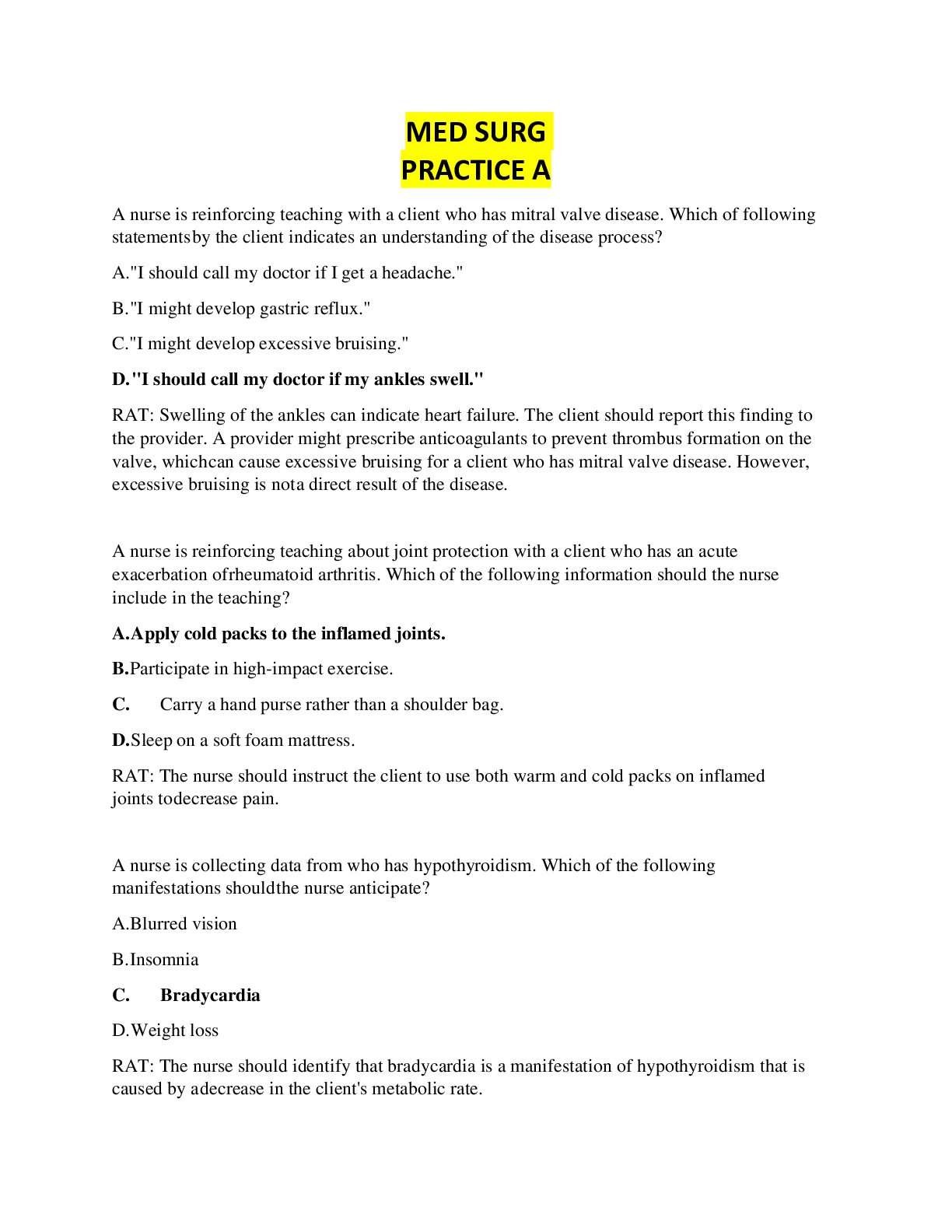
Buy this document to get the full access instantly
Instant Download Access after purchase
Add to cartInstant download
Reviews( 0 )
Document information
Connected school, study & course
About the document
Uploaded On
May 11, 2022
Number of pages
55
Written in
Additional information
This document has been written for:
Uploaded
May 11, 2022
Downloads
0
Views
40





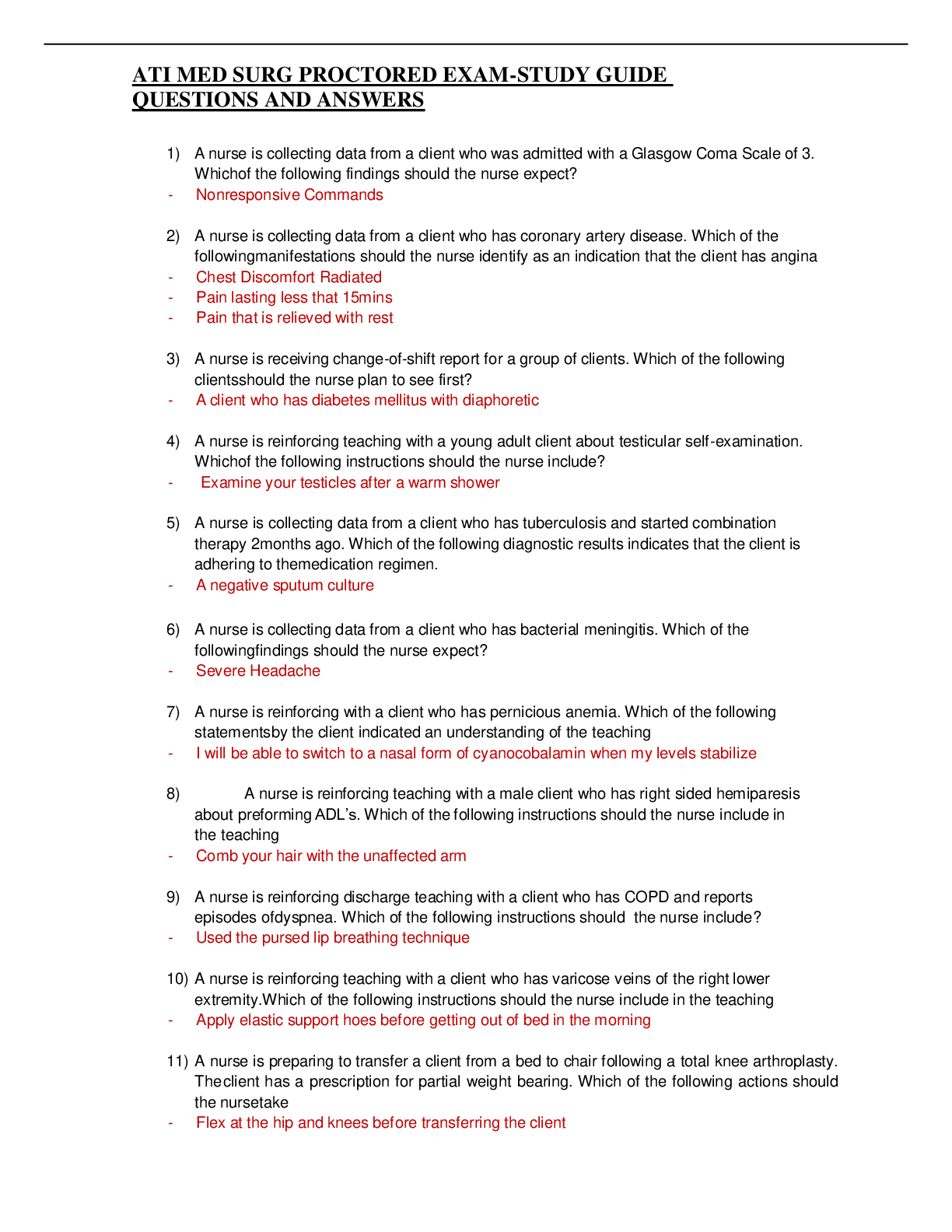
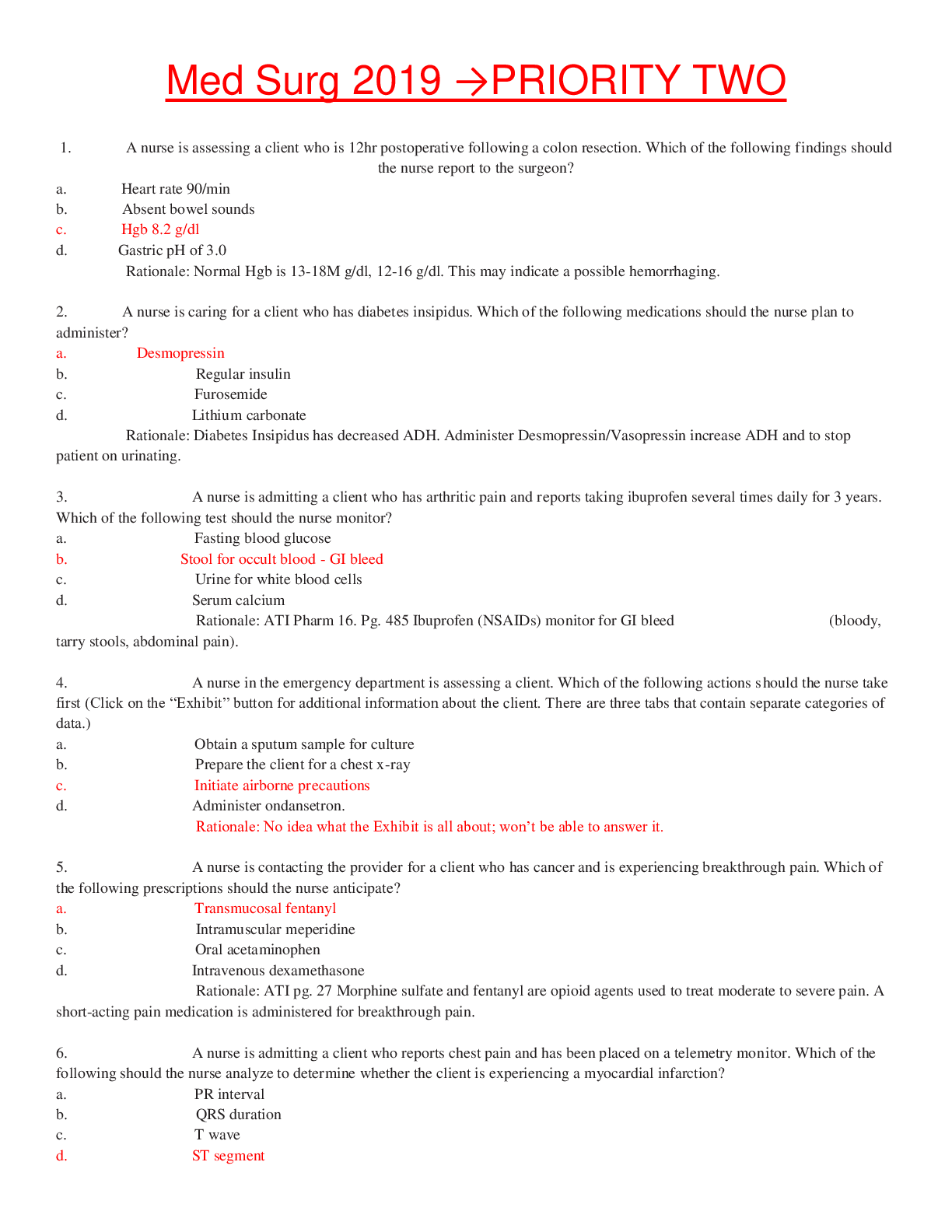


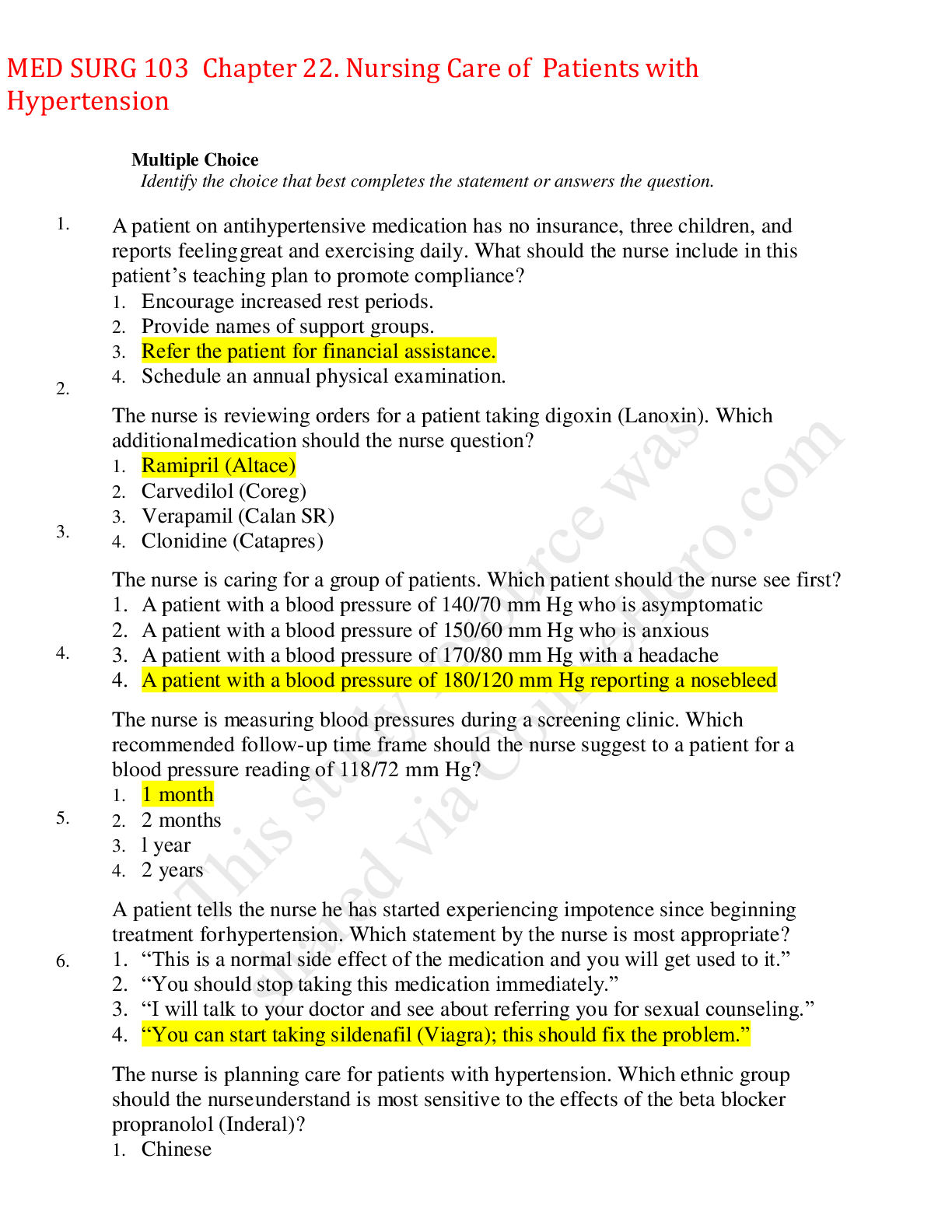
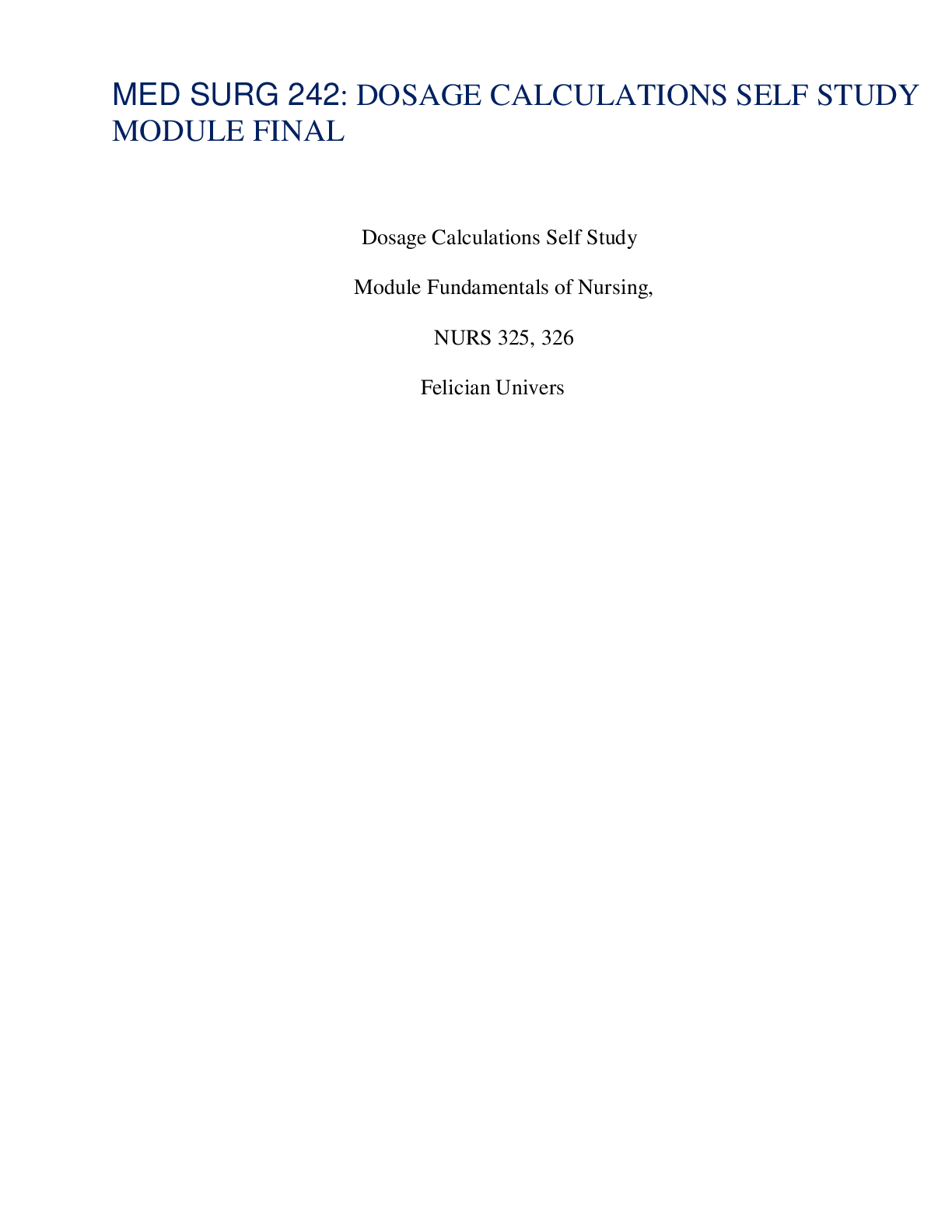


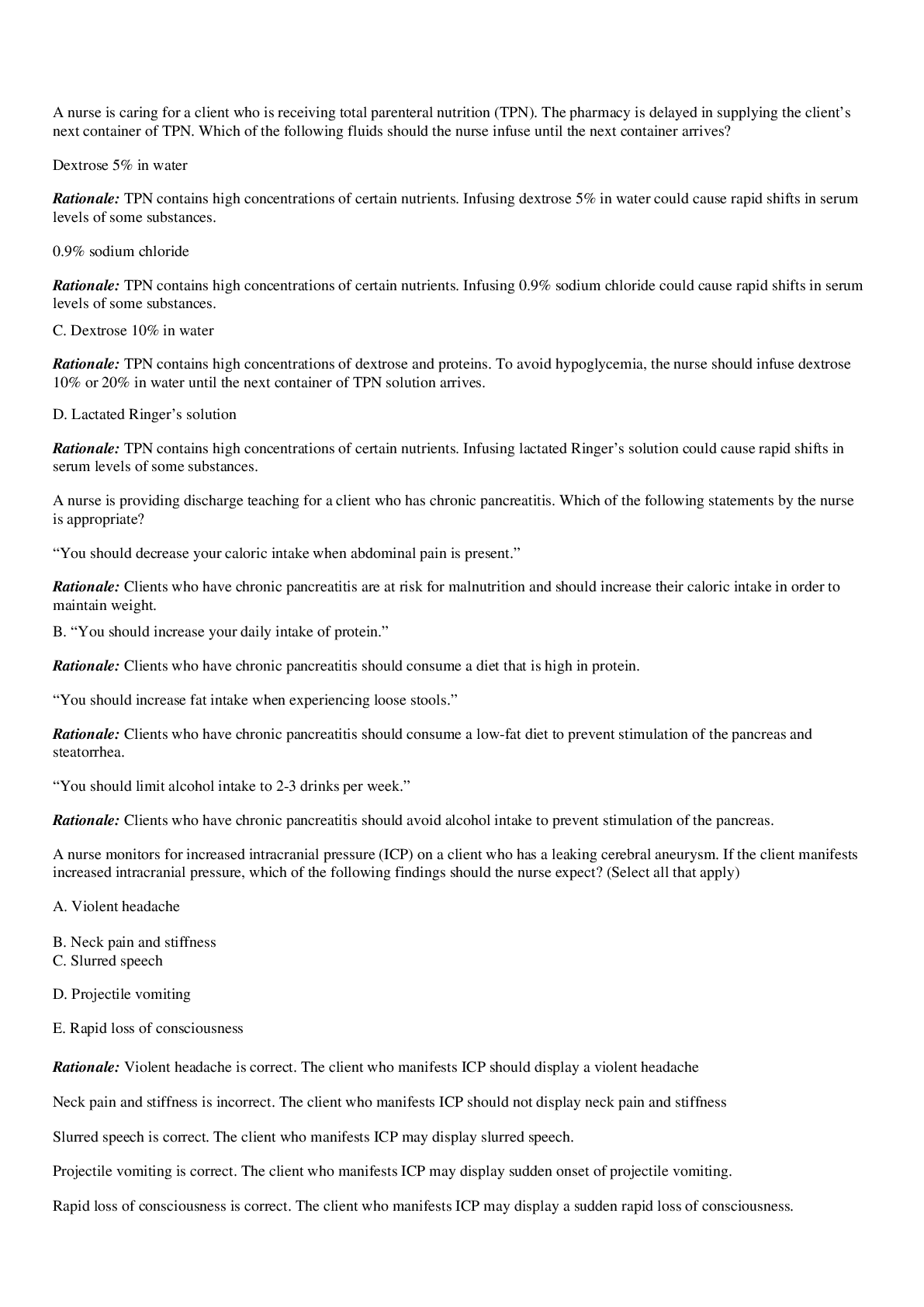
.png)
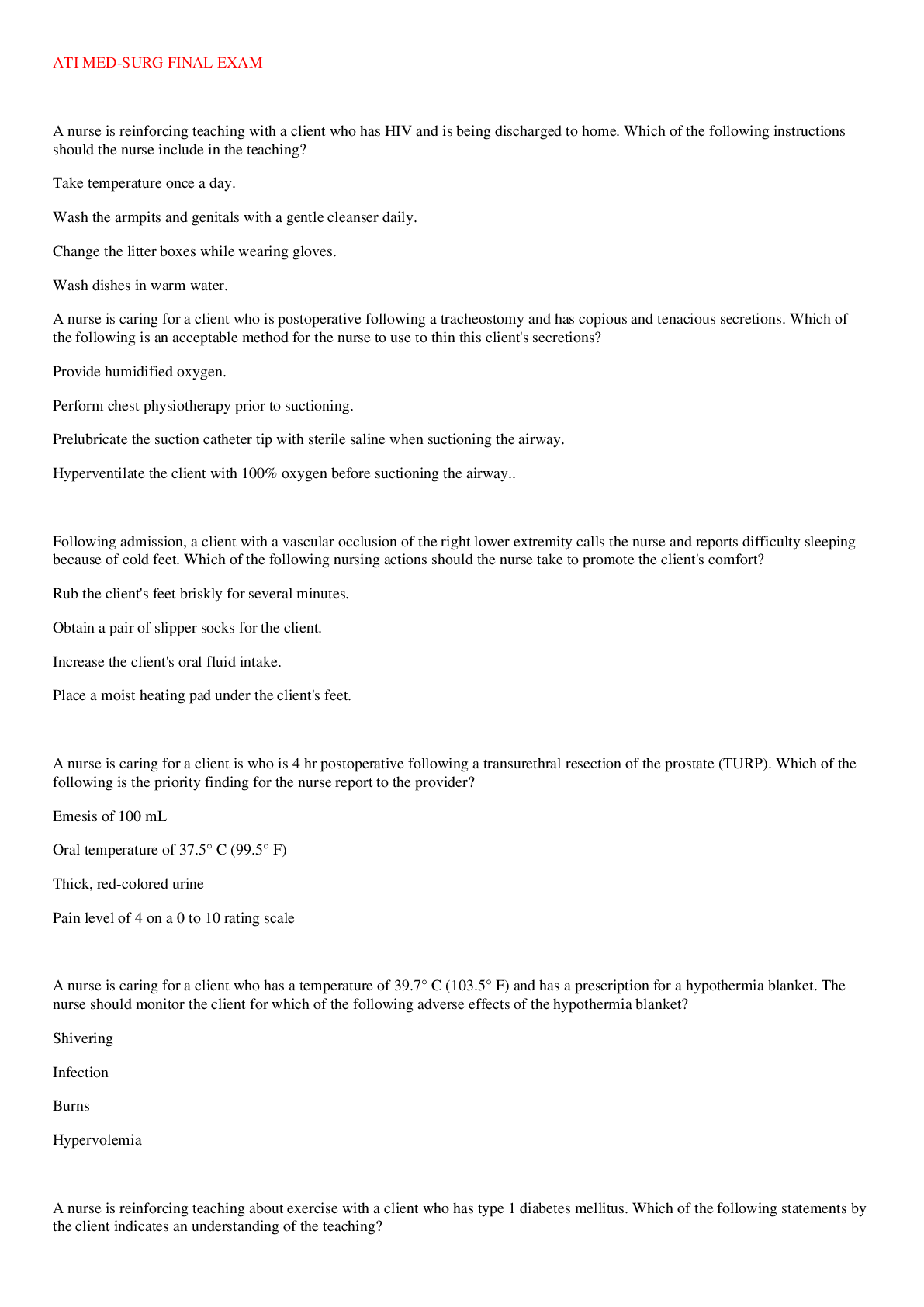
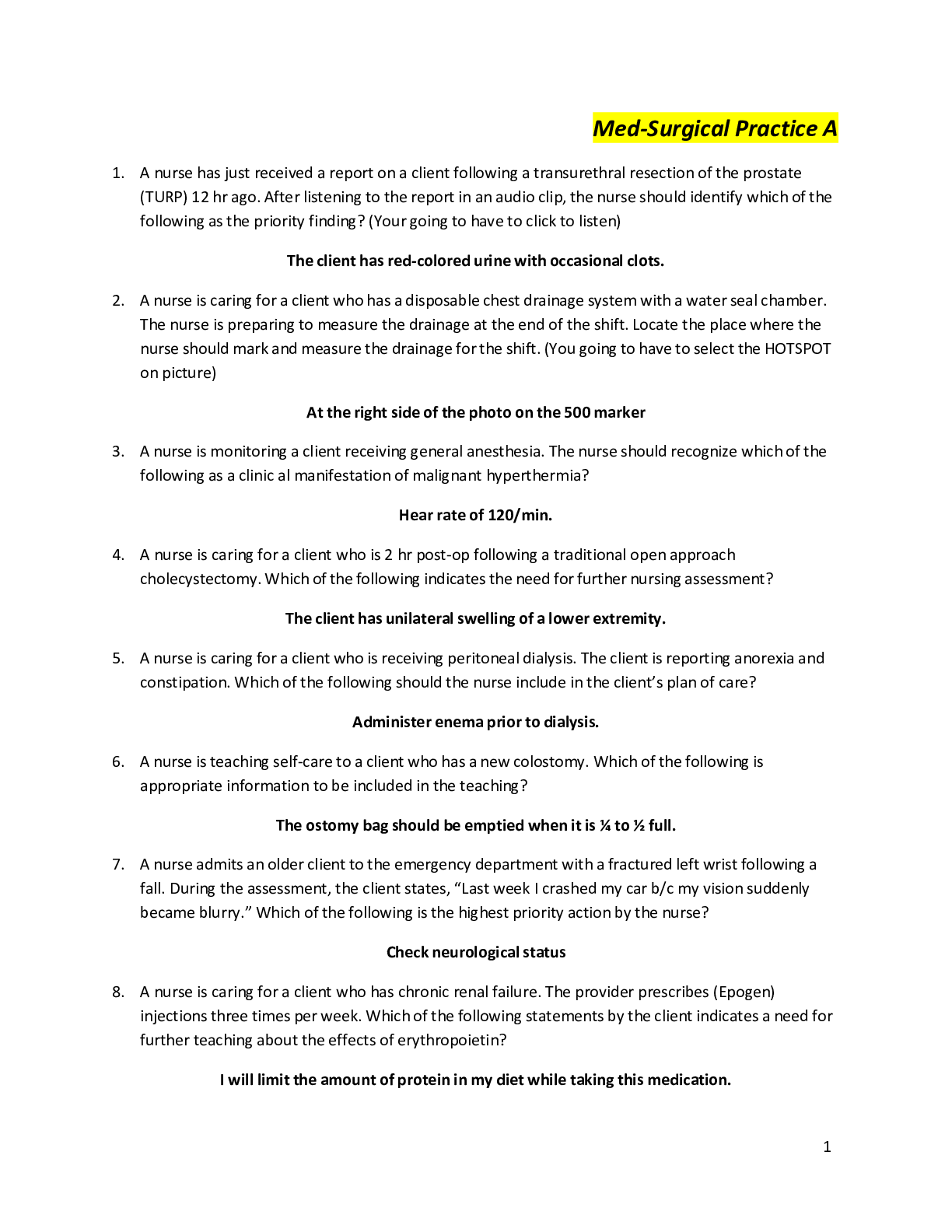


.png)


